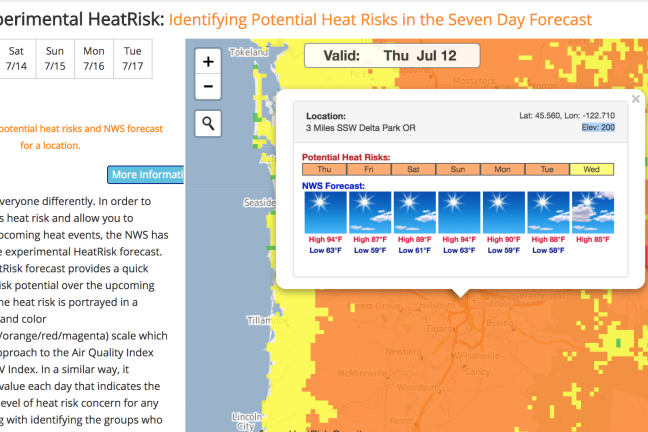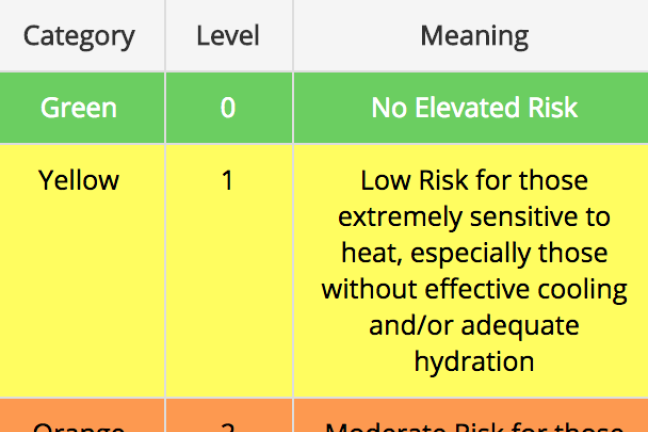Multnomah County has adopted a new protocol for responding to excessive heat, following guidance set by the National Weather Service. The new thresholds for issuing health warnings and opening cooling spaces are based on 30 years of historical temperatures and data on health-related illnesses and heat-related emergency room visits.
The National Weather Service spent four years developing their Heat Risk Tool as guidance for forecasters who issue heat advisories and warnings across the United States.
When an area on the map flashes red, the weather service could issue a Heat Advisory or Excessive Heat Warning. That would trigger Multnomah County and a local network of agencies and providers to coordinate protective measures, such as a public awareness campaign or support for air-conditioned buildings such as libraries and community centers, where people might go to escape the heat. The county may also decide to activate cooling centers.
When an area of the Heat Risk map indicates a risk level of 4, coded by the color magenta, the region should prepare for multiple days of excessive heat. This would likely prompt the NWS to issue an Excessive Heat Warning. The county would then activate cooling centers and take other measures upon request from local agencies and providers.
In the past, when Multnomah County opened cooling centers when temperatures reached 95 degrees for two or more consecutive days, or remained above 90 degrees for 5 consecutive days. But people often opted to visit an area pool or library instead.
“With the previous thresholds we had one tool, and it was cooling centers. We realized that in some cases the resources we were putting in weren’t matching the need,” said Brendon Haggerty, who monitors climate-related health issues for Multnomah County Environmental Health Services. “We have a full suite of resources. So we can rely on less-intensive tools if the heat is going to be less intense. Part of what I like is there is pretty strong evidence that heat warning systems are effective in reducing heat related illness.”
The Multnomah County Office of Emergency Management works with neighboring counties to coordinate a regional response to excessive heat. Following advice from Environmental Health to include important elements that result in a more comprehensive measure than daytime highs, when making recommendations on what agencies and organizations should do during hot weather.
"We used to open cooling centers based just on temperatures we thought were hot, rather than science" said Chris Voss, director of Multnomah County Emergency Management. "This new process uses high temperatures, nighttime low temperatures, humidity to help us determine when best to open up additional places to stay cool."
The Heat Risk tool rolls out this year across the western United States, the culmination of four years of research and planning by staff with the National Weather Service. They combed through academic studies on heat-related illness and analyzed record temperatures as well as average highs for 1,400 cities across the country. They factored in humidity, the length of heat waves, potential for cooling marine winds, and nighttime lows. And they pulled data from the Centers for Disease Control and Prevention to identify the conditions under which emergency rooms began to report heat-related visits.
“Forecasters use this as a guidance. Now we have this tool that provides an outlook of potential heat episodes seven days out,” said Tyree Wilde, warning coordination meteorologist with the National Weather Service. “So we can see that if it’s orange or red, we can start messaging: ‘There’s going to be a warming spell, so people who work outside such as construction workers, people who exercise outside, or people susceptible to heat should avoid doing those activities during the hottest part of the day, drink a lot of fluids to stay hydrated and get into a cool shelter, if possible.’”


